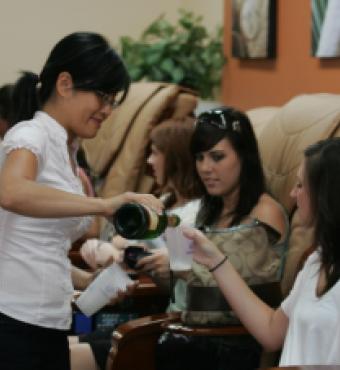- Law & Policy
The New York Times recently published two wildly celebrated articles by journalist Sarah Maslin Nir. The first article, “The Price of Nice Nails,” describes in painful and accurate detail the trials and tribulations in the manicurist trade in New York City and elsewhere. The second article, “Perfect Nails, Poisoned Workers,” documents the health risks to which manicurists in the trade are exposed.
In this age of strong populist discontent with the state of American labor markets, Nir does not pull any punches in condemning the abusive practices in this rapidly growing industry, which is largely serviced by Korean, Chinese, Nepalese, and Hispanic women: “Manicurists are routinely underpaid and exploited, and endure ethnic bias and other abuse.” Her investigation documents the tyrannical practices of the small business owners who employ the manicurists. Whatever the benefits of cheap manicures may be for the people of New York City and nearby communities, Nir argues that they exact a human toll, moral and physical, on the young immigrant women of Asia and Latin America.
The two articles have provoked a huge public reaction. New York Governor Andrew Cuomo has announced “Emergency Measures” and immediate “salon by salon” enforcement to make sure that health abuses and “wage theft” will be blocked. The salons that do not comply will be shut down.
Nir’s articles have been met with widespread approval. It is for precisely this reason that it is necessary to slow down and ask whether Nir’s revelations, even if true, justify Governor Cuomo’s actions. My fear, quite simply, is that his vigorous enforcement efforts will leave matters worse off than before.
The key point here is that Nir’s story does not fully hold together when tested against the standard lessons of economic theory and history. My critique of Nir’s narrative rests on a key assumption about human behavior. In economic matters, people generally try to maximize their own self-interest even when faced with few options and severe constraints.
Today, the manicure trade is booming. The number of shops in Manhattan continues to grow rapidly, notwithstanding the awful conditions and low wages that the workers endure. The unpleasant and dangerous nature of the working conditions is no secret to the women who work daily in the trade. Nir opens her piece by describing the large numbers of Asian and Hispanic women who regularly line up early in the morning on the streets of Queens waiting for “cavalcades of battered Ford Econoline vans” to pick them up and whisk them away to their work sites. The simple question is this: Why do these women come back day after day to the same location for rides to the same jobs if the situation is as toxic as Nir paints it?
Nir does not identify what brings them back. If they were worse off taking these jobs, at least some of them would move into other lines of work with higher pay and better working conditions. But these women are repeat players, and at least some of them slowly get improved wages and better work conditions from their hard-boiled employers. On this score, the standard economic test is whether these women are worse in their current jobs than with their next best alternative—an alternative universe that is left unidentified and unexplored by Nir. Some obvious possibilities for the women who quit is to not work at all, or to work in dangerous trades like drugs or prostitution where the results for these displaced women could be worse. Jobs in legal markets may well be foreclosed by a high minimum wage law, which further reduces their set of choices, as does their weak or nonexistent command of English.
In the long-term, these women may live to regret their choices, especially in light of the poor health outcomes they may suffer. But there is no long-run unless the women can survive in the short-run. It is for that reason that health issues may prove the most knotty. To some extent, the long-term dangers are latent. Nir’s articles thus perform a genuine public service by highlighting to all concerned the dangers of working in this environment.
But even here it is difficult to attribute the poor outcomes to employer exploitation. The most poignant example of health risks that Nir offers is of Eugenia Colon who was the owner of the nail salon in which she contracted her lung damage, working side-by-side with her employees. Clearly, simple precautions like wearing masks may well make sense in that environment. It may also be possible to eliminate the use of various nail polishes and other preparations that carry with them the worst possible risks.
The best remedy here may not be Governor Cuomo’s edict to shut down noncompliant salons. Once the information from Nir’s article gets out, both workers and customers will, however imperfectly, start to take the health risks into account. The volume of business at risky salons should go down, and the prices should go up—a wholly appropriate response now that the health risks have become more salient.
The underlying economic issues must be addressed as well. The intense demand for jobs pushes the supply curve outward, which means that more workers will be employed at lower wages, everything else being equal. No one knows for sure exactly what alternatives these women might have or how well they might pay. But we do know this: It is highly unlikely that the women in question lack key information about their current conditions. Yet they choose to return again and again.
One reason they return is, as Nir notes, that the demand for new workers seems practically insatiable. That extra demand should offset in part the downward pressure on wages from the high supply. But nothing says that the two forces are of equal magnitude. And the market evidence suggests that, on net, the higher supply drives wages lower. The low wages are no secret insofar as local Asian newspapers are “rife” with advertisements offering as little as $10 per day for the work in question, and requiring new recruits to pay $100 in cash to learn the trade. It is not, therefore, as though potential employers commit fraud to tap new supplies of naïve employees. Nor do they exercise coercion by, for example, stripping guileless applicants of their passports to prevent them from returning home. The economic theory of revealed preferences suggests that the opportunities offered by these shops are as good as these women can find anywhere else.
In dealing with the governor’s options, it is important to realize how little room he has to maneuver. Thus, looking at the employer side of the industry, it is hard to see how small firms can collude to keep wages low. Entry and exit into this industry is relatively easy, for literally hundreds of small shops offer manicures at cheap prices in New York City alone, charging an average of under $11.00 per session, or roughly half the national rate. These firms could not collude on wages even if they wanted to, for rampant cheating for the best workers would break up their joint efforts.
In this highly competitive industry, low prices bring and retain customers, rich and poor. Those low prices translate into low profit margins for most employers and low wages for their employees. Even the most successful employers know that they sit on the knife’s edge: if they raise their prices, they will lose their customers to a nearby shop. If they lower their prices, they will not be able to cover their costs. The vice-like equilibrium of competitive markets comports with the facts on the ground.
Last, what about the discrimination that goes on at these salons, with Korean manicurists being at the top of the pecking order, making the most money and earning the most privileges, and Hispanics being at the bottom, as Nir describes? That too, for better or worse, persists in at least some competitive markets. Employers lose big if they make mistakes in estimating the abilities of their workers. If they pay higher wages to less productive workers, their competitors who don’t make that mistake will drive them out of business. Perhaps the Korean proprietors have nasty stereotypes about their Hispanic employees. But the harder question is whether these nasty stereotypes are true generalizations about the relative average productivity of different work classes.
If the Korean shop owners are wrong, other firms can enter the business and scoop up underpaid Chinese, Nepalese, and Hispanic workers—at least if entry is free. Right now, about a quarter of the shops are owned by members of other ethnic groups. It would be instructive to know their pay scales as well. To be sure, if the dominant Korean group could use force to block new entry, that behavior should be punished. But Nir’s account offers no evidence of intimidation against new entrants.
Once there are no illicit barriers to entry, the analysis flips over. Gary Becker’s path-breaking hypothesis—that invidious discrimination cannot survive in competitive markets—rings true nearly sixty years after it was published. Labor markets are too complicated to be captured in any stick-pin economic model, for workers are human beings not standardized commodities. Yet, as I argued a long time ago in Forbidden Grounds, these complexities argue against, not for, government regulation of labor markets.
Take the question of firm composition. One good guess is that small firms offer opportunities for substantial gains from racial separation. Common tastes, customs, and language within ethnic groups make it easier to provide standardized background conditions for all workers, which could matter on such mundane matters as to what music is piped into common areas. What goes on in the workplace can be bolstered by cooperative relationships outside the job.
Yet that form of racial and ethnic separation is likely to prove fatal in larger firms trying to reach a broad portion of the market. These firms typically find it indispensable to draw their work force from all racial and ethnic groups in order to service their diverse customer base. So long as the insiders know more than the outsiders, including outside regulators, invoking the antidiscrimination or minimum wage laws is generally a mistake.
Here is why: However unattractive the current market equilibrium may be, if the government intervenes to try to make the situation for employees better, it could easily, even on wage and health regulation, actually make things worse. Before Governor Cuomo leaped into the fray, Nir’s article observed that federal and state labor laws are not being enforced in the industry on such key topics as discrimination and the minimum wage. Many employees are reluctant to cooperate with public authorities because they sense that the enforcement of these protective laws will cost them their jobs. At this point, the antidiscrimination laws and the maximum hours and minimum wage laws operate as a huge tax on fragile employment decisions.
The health laws too can have this effect if they go so far as to shut down the businesses, leaving the workers, owners, and customers to fend for themselves, sometimes in underground establishments that are riskier than the above-board shops they displace.
In effect, each round of regulation, regardless of its particular design, will create a wedge between what the employer pays and what the employee gets. We know that minimum wage laws have especially hard effects on young minority teenagers who are priced out of the market. Regulating nail salons will have a similar effect. Some of the regulated firms will go out of business; some of the firms will contract services, raise prices, and survive. But many workers will lose their jobs, only to find their reentry into the labor market blocked by high minimum wages and strong antidiscrimination laws.
These cautious observations are not just idle speculation. Over a century ago, the target of much well-intentioned indignation was the child labor laws, which sought to keep young children out of the marketplace until they reached, say, the ages of 14 or 16. The evidence, assiduously gathered by economist Benjamin Powell in his work on sweatshops and child labor, shows that these laws hurt the very children they were intended to help by driving them into begging, prostitution, or crime. Deprived of their best option, their families had only inferior options, and the results were not pretty.
So what then should be done? It is clear that there is no political will to provide these workers with public subsidies tied to their low income. Any intervention will therefore take place on the regulatory side. As should be evident, the best way to help these manicurists is by giving them more options. Make sure that new firms are free to enter the business, and make sure that workers in the industry who want to leave are not blocked from getting other jobs by minimum wage laws and antidiscrimination laws. Governor Cuomo, acting out of righteous indignation, may be moving too far in the wrong direction by stepping up enforcement of the current laws when the right result may be to tack in the opposite direction, and making a strong priority of system-wide deregulation.
















